Numerical Simulation Prediction of Erosion Characteristics in a Double-Suction Centrifugal Pump
Abstract
:1. Introduction
2. Materials and Methods
2.1. Research Object
2.2. Basic Equation of Particle Motion
2.3. Erosion Model
2.4. Calculation Method for Solution
3. Discussion of Calculation Results
3.1. Verification of Calculation Scheme and Reliability
3.2. Analysis of Flow and Erosion in Double-Suction Pumps under Different Flow Conditions
3.2.1. Influence of Flow Rate on Particle Movement
3.2.2. Effect of Flow Rate on Surface Erosion
3.2.3. Local Erosion Caused by Vortex in Impeller
3.3. Effect of Particle Concentration on Erosion Characteristics
3.3.1. Influence of Particle Concentration on Particle Tracks
3.3.2. Effect of Particle Concentration on Erosion Characteristics
4. Conclusions
Author Contributions
Funding
Institutional Review Board Statement
Informed Consent Statement
Data Availability Statement
Conflicts of Interest
References
- Wang, J.Q.; Jiang, W.M.; Kong, F.Y.; Li, H. Numerical simulation of solid-liquid two-phase turbulent flow and erosion characteristics of centrifugal pump. Trans. Chin. Soc. Agric. Mach. 2013, 44, 53–60. (In Chinese) [Google Scholar]
- Huang, S.; Su, X.; Qiu, G. Transient numerical simulation for solid-liquid flow in a centrifugal pump by DEM-CFD coupling. Eng. Appl. Comput. Fluid Mech. 2015, 9, 411–418. [Google Scholar] [CrossRef] [Green Version]
- Yellow River Conservancy Commission of the Ministry of Water Resources Sediment Source and Its Characteristics. Available online: http://www.yellowriver.gov.cn/hhyl/hhgk/hs/ns (accessed on 15 May 2002).
- Song, X.J.; Liu, C. Experimental investigation of floor-attached vortex effects on the pressure pulsation at the bottom of the axial flow pump sump. Renew. Energy 2020, 145, 2327–2336. [Google Scholar] [CrossRef]
- Song, X.J.; Liu, C. Experimental study of the floor-attached vortices in pump sump using V3V. Renew. Energy 2021, 164, 752–766. [Google Scholar] [CrossRef]
- Qian, Z.; Wang, Z.; Zhang, K.; Wu, Y.; Wu, Y. Analysis of silt erosion and blade shape optimization in a centrifugal pump. Proc. Inst. Mech. Eng. Part A J. Power Energy 2014, 228, 585–591. [Google Scholar] [CrossRef]
- Hongyuan, X. A study on motion of solid particles in centrifugal pump impeller. Fluid Mach. 1992, 20, 1–6. (In Chinese) [Google Scholar]
- Liu, J.; Xu, H.Y.; Tang, S.; Li, L. Numerical simulation of erosion and particle motion trajectory in centrifugal pump. Trans. Chin. Soc. Agric. Mach. 2008, 39, 54–59. (In Chinese) [Google Scholar]
- Xu, H.Y.; Wu, Y.L.; Gao, Z.Q. Experimental study and numerical analysis of the motion of dilute soild particles in centrifugal pump impellers. J. Hydraul. Eng. 1997, 9, 12–18. (In Chinese) [Google Scholar]
- Edwards, J.K.; McLaury, B.S.; Shirazi, S.A. Modeling solid particle erosion in elbows and plugged tees. J. Energy Resour. Technol. 2001, 123, 277–284. [Google Scholar] [CrossRef]
- Zhang, J.; Darihaki, F.; Shirazi, S.A. A comprehensive CFD-based erosion pre-diction for sharp bend geometry with examination of grid effect. Wear 2019, 430, 191–201. [Google Scholar] [CrossRef]
- Finnie, I. Erosion of surfaces by solid particles. Wear 1960, 3, 87–103. [Google Scholar] [CrossRef]
- Grant, G.; Tabakoff, W. Erosion prediction in turbomachinery resulting from environmental solid particles. J. Aircr. 1975, 12, 471–478. [Google Scholar] [CrossRef]
- Takaffoli, M.; Papini, M. Numerical simulation of solid particle impacts on Al6061-T6 partI: Three-dimensional representation of angular particles. Wear 2012, 292, 100–110. [Google Scholar] [CrossRef]
- Takaffoli, M.; Papini, M. Numerical simulation of solid particle impacts on Al6061-T6 PartII: Materials removal mechanisms for impact of multiple angular particles. Wear 2012, 296, 648–655. [Google Scholar] [CrossRef]
- Engin, T.; Gur, M. Performance characteristics of a centrifugal pump impeller with running tip clearance pumping solid-liquid mixtures. J. Fluids Eng. 2001, 123, 532–538. [Google Scholar] [CrossRef]
- Khurana, S.; Goel, V.; Singh, G. Effect of Silt and Jet Diameter on Performance of Turbo Impulse Hydro-Turbine. In Fluids Engineering Division Summer Meeting; American Society of Mechanical Engineers: New York, NY, USA, 2017. [Google Scholar]
- Nguyen, V.B.; Nguyen, Q.B.; Zhang, Y.W.; Lim, C.Y.H.; Khoo, B.C. Effect of particle size on erosion characteristics. Wear 2016, 348, 126–137. [Google Scholar] [CrossRef]
- Shen, Z.; Chu, W.; Li, X.; Dong, W. Sediment erosion in the impeller of a double-suction centrifugal pump–A case study of the Jing tai Yellow River Irrigation Project, China. Wear 2019, 422, 269–279. [Google Scholar] [CrossRef]
- Lospa, A.M.; Dudu, C.; Ripeanu, R.G.; Dinita, A. CFD Evaluation of sand erosion erosion rate in pipe bends used in technological installations. In IOP Conference Series: Materials Science and Engineering, Proceedings of the Product Design, Robotics, Advanced Mechanical and Mechatronic Systems and Innovation Conference (PRASIC), Bangkok, Thailand, 23–25 July 2019; IOP Publishing: Bristol, UK, 2019. [Google Scholar]
- Vieira, R.E.; Parsi, M.; Zahedi, P.; McLaury, B.S.; Shirazi, S.A. Sand erosion measurements under multiphase annular flow conditions in a horizontal-horizontal elbow. Powder Technol. 2017, 320, 625–636. [Google Scholar] [CrossRef]
- Bhosale, D.G.; Prabhu, T.R.; Rathod, W.S.; Patil, M.A.; Rukhande, S.W. High temperature solid particle erosion behavior of SS316L and thermal sprayed WC-Cr3C2-Ni coatings. Wear 2020, 462, 203520. [Google Scholar] [CrossRef]
- Wang, X.; Fang, M.; Zhang, L.C.; Ding, H.; Liu, Y.G.; Huang, Z.; Yang, J. Solid particle erosion of alumina ceramics at elevated temperature. Mater. Chem. Phys. 2013, 139, 765–769. [Google Scholar] [CrossRef]
- Li, X.; Ding, H.; Huang, Z. Solid particle erosion-erosion behavior of SiC-Si3N4 composite ceramic at elevated temperature. Ceram. Int. 2014, 40, 16201–16207. [Google Scholar] [CrossRef]
- Song, X.; Yao, R.; Shen, Y.; Bi, H.; Zhang, Y.; Du, L.; Wang, Z. Numerical Prediction of Erosion Based on the Solid-Liquid Two-Phase Flow in a Double-Suction Centrifugal Pump. J. Mar. Sci. Eng. 2021, 9, 836. [Google Scholar] [CrossRef]
- Gahlot, V.K.; Seshadri, V.; Malhotra, R.C. Effect of density, size, distribution, and concentration of solid on the characteristics of centrifugal pumps. J. Fluid Eng. T ASME 1992, 114, 386–389. [Google Scholar] [CrossRef]
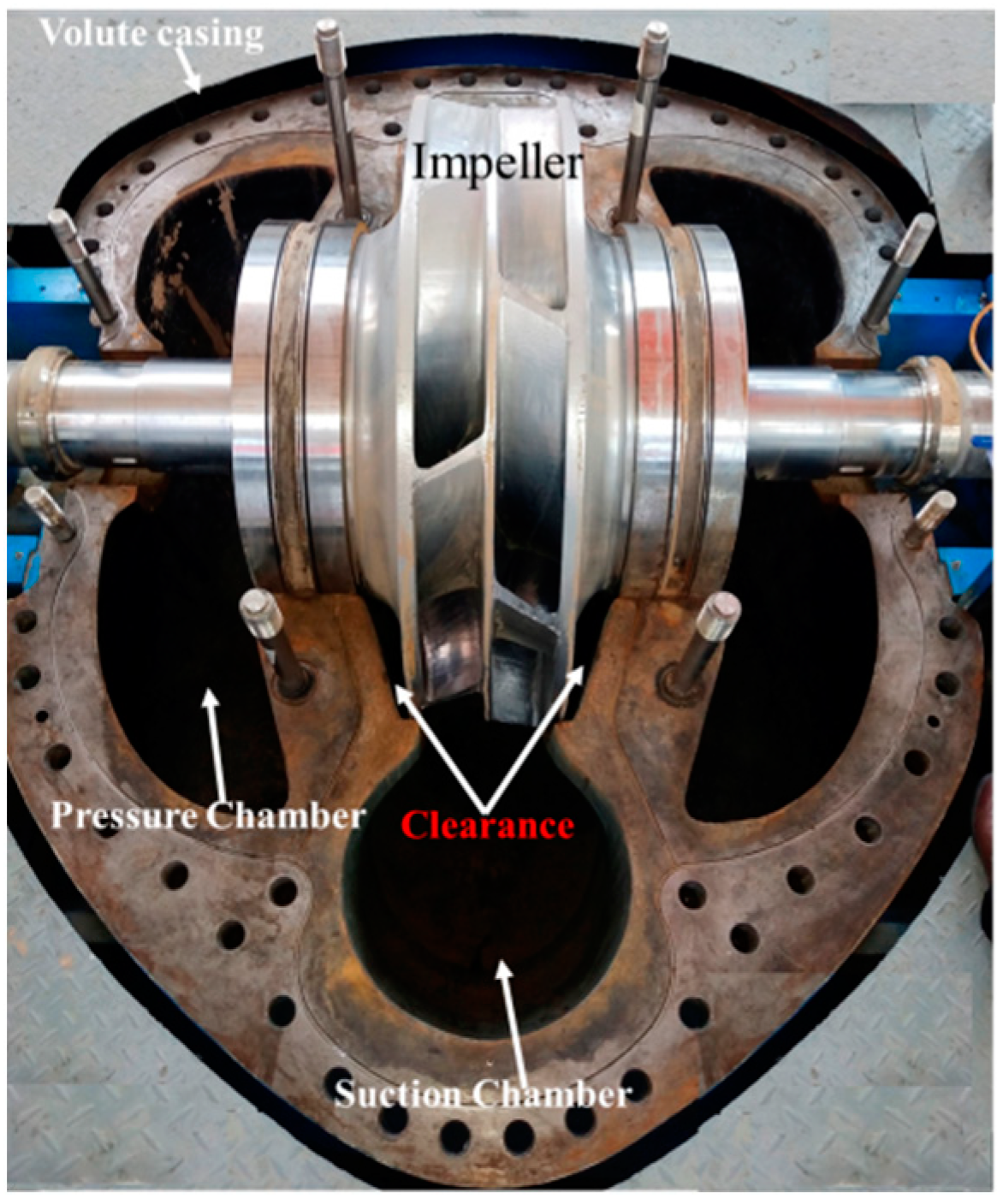
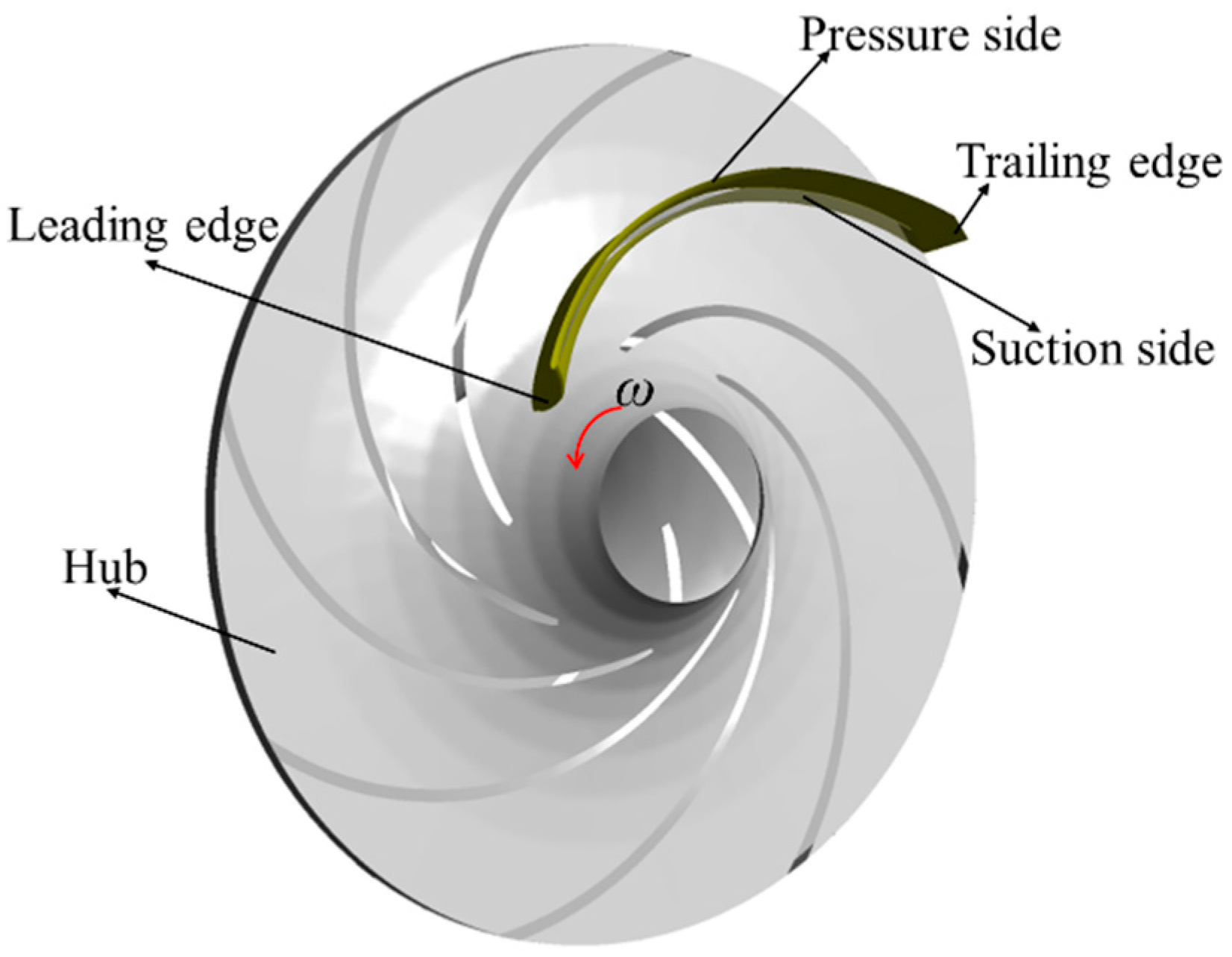

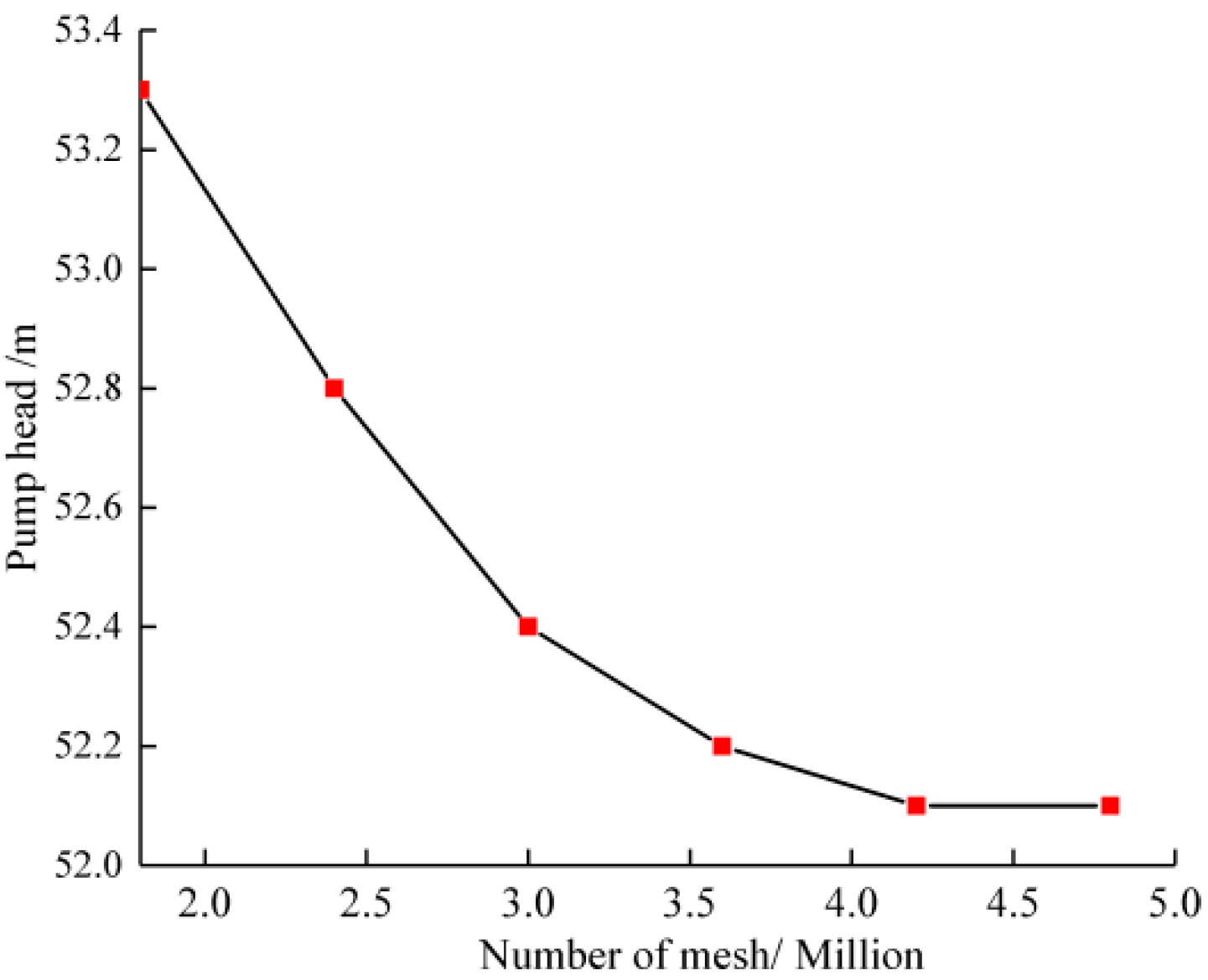
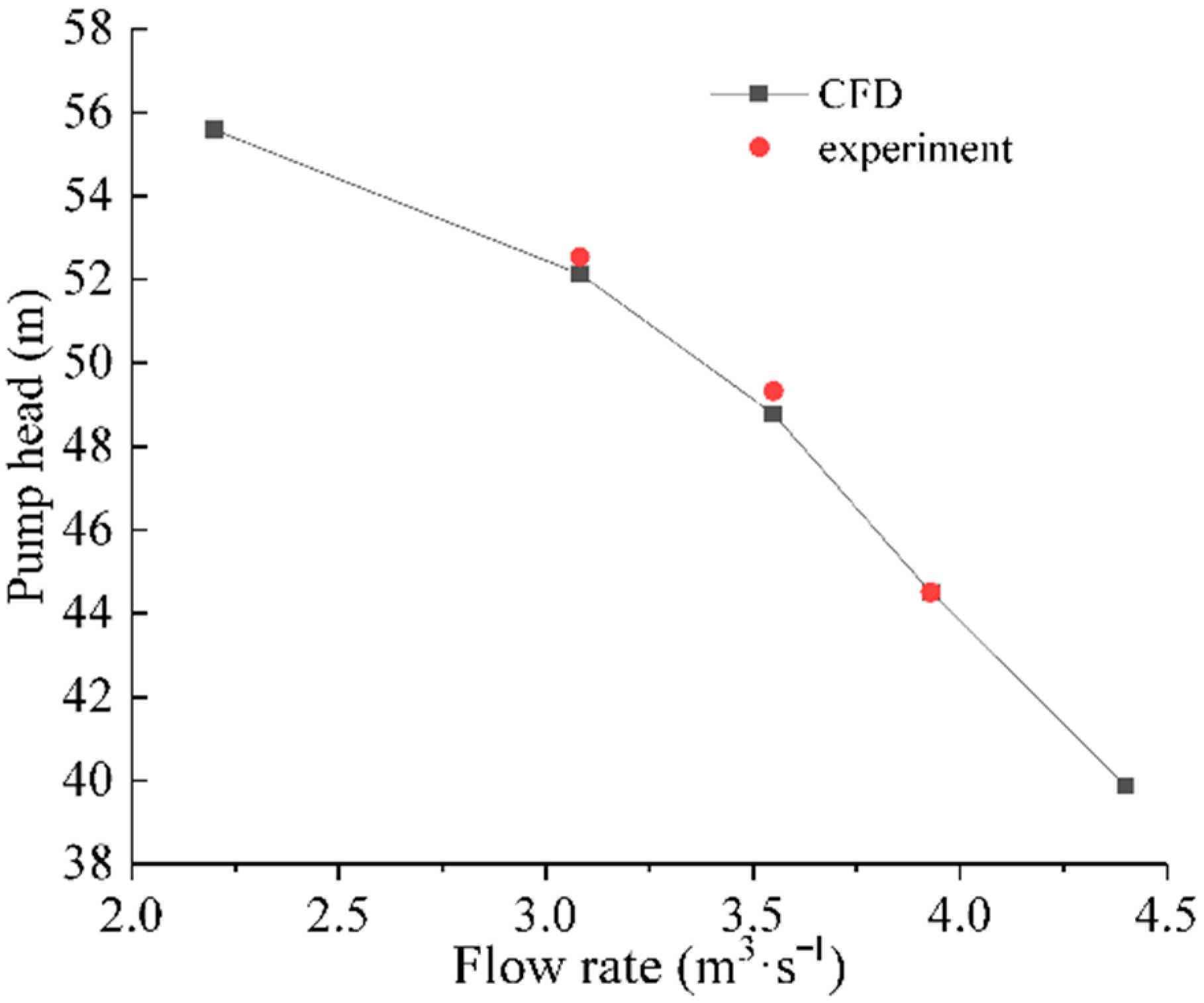









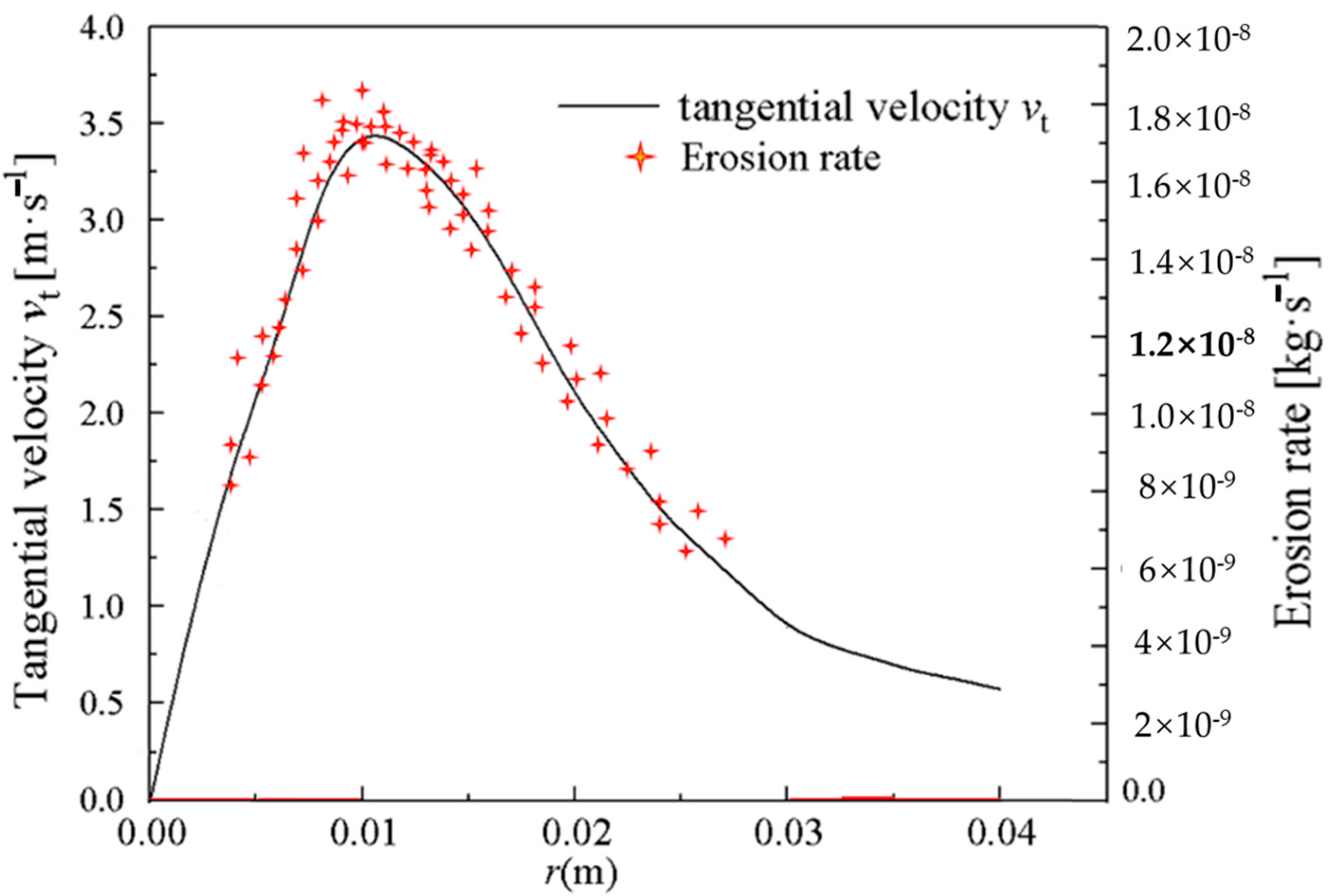





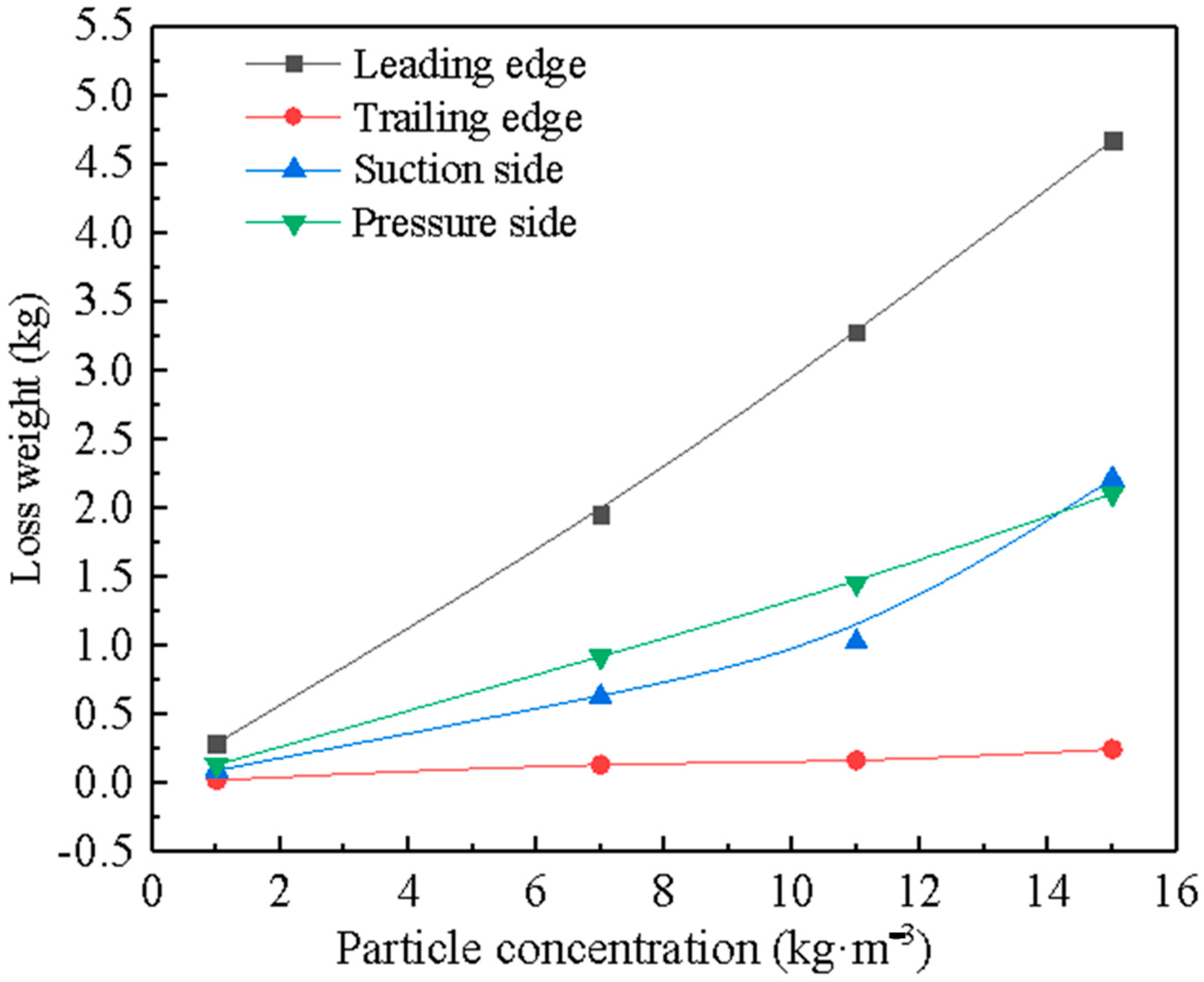
| Parameter | Scheme Number | |||||
|---|---|---|---|---|---|---|
| 1 | 2 | 3 | 4 | 5 | 6 | |
| Flow rate (m3/s) | 0.25Qd | Qd | 1.27Qd | Qd | Qd | Qd |
| particle concentration (kg/m3) | 15 | 15 | 15 | 11 | 7 | 1 |
Publisher’s Note: MDPI stays neutral with regard to jurisdictional claims in published maps and institutional affiliations. |
© 2021 by the authors. Licensee MDPI, Basel, Switzerland. This article is an open access article distributed under the terms and conditions of the Creative Commons Attribution (CC BY) license (https://creativecommons.org/licenses/by/4.0/).
Share and Cite
Song, X.; Qi, D.; Xu, L.; Shen, Y.; Wang, W.; Wang, Z.; Liu, Y. Numerical Simulation Prediction of Erosion Characteristics in a Double-Suction Centrifugal Pump. Processes 2021, 9, 1483. https://doi.org/10.3390/pr9091483
Song X, Qi D, Xu L, Shen Y, Wang W, Wang Z, Liu Y. Numerical Simulation Prediction of Erosion Characteristics in a Double-Suction Centrifugal Pump. Processes. 2021; 9(9):1483. https://doi.org/10.3390/pr9091483
Chicago/Turabian StyleSong, Xijie, Dunzhe Qi, Lijuan Xu, Yubin Shen, Wei Wang, Zhengwei Wang, and Yan Liu. 2021. "Numerical Simulation Prediction of Erosion Characteristics in a Double-Suction Centrifugal Pump" Processes 9, no. 9: 1483. https://doi.org/10.3390/pr9091483
APA StyleSong, X., Qi, D., Xu, L., Shen, Y., Wang, W., Wang, Z., & Liu, Y. (2021). Numerical Simulation Prediction of Erosion Characteristics in a Double-Suction Centrifugal Pump. Processes, 9(9), 1483. https://doi.org/10.3390/pr9091483







